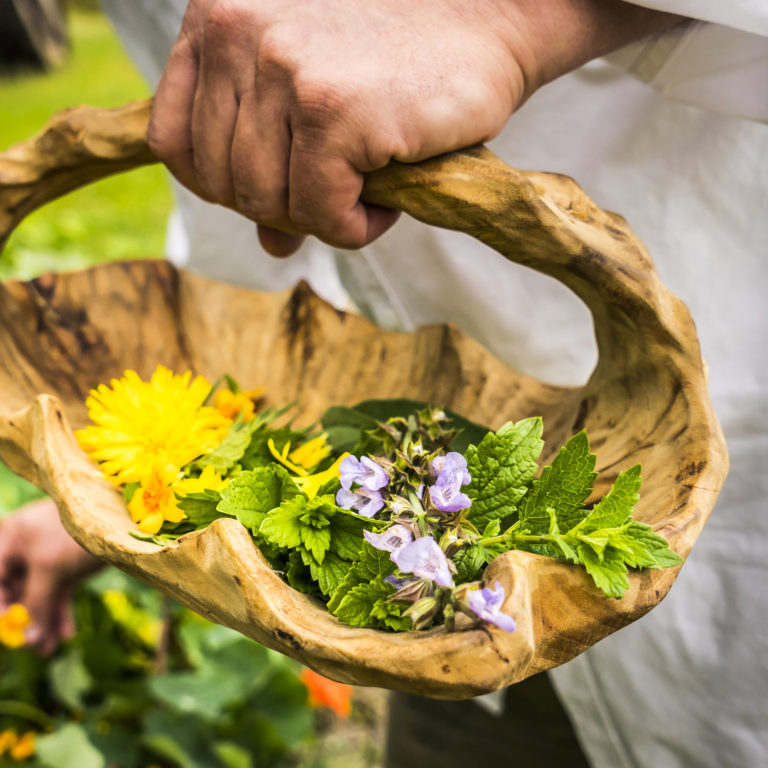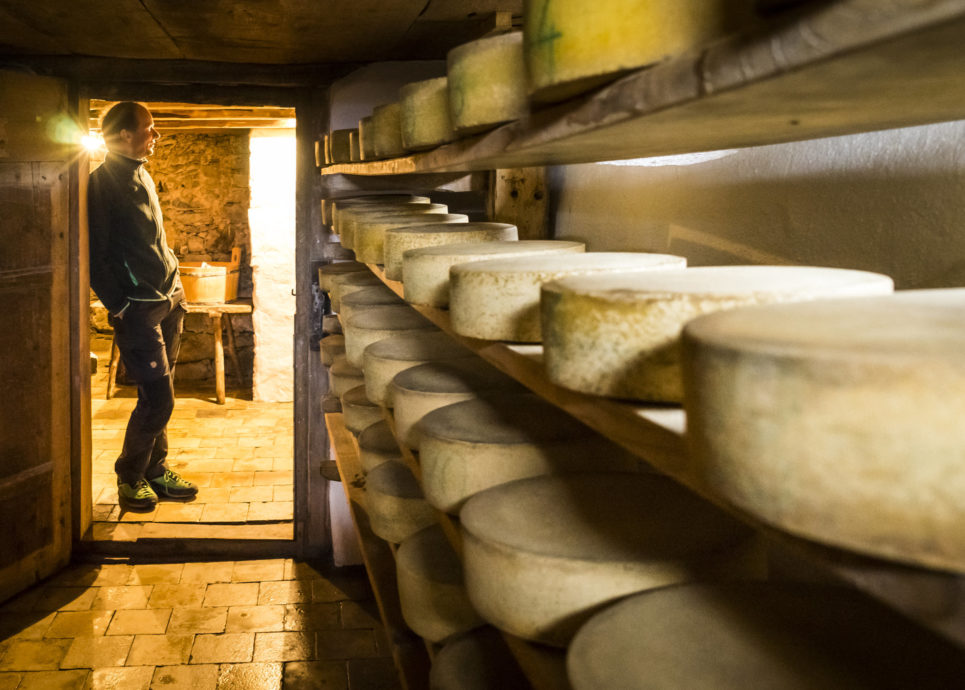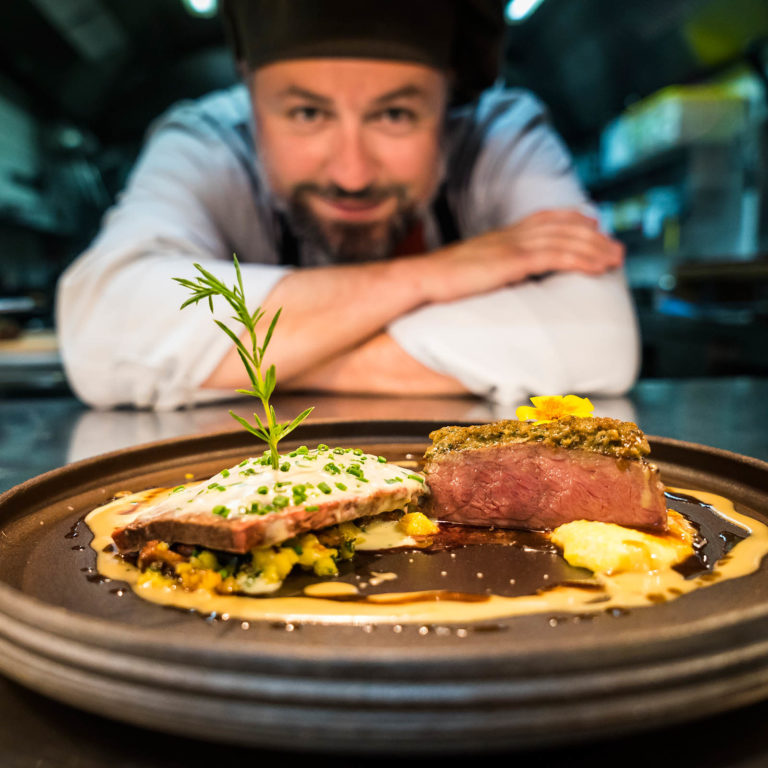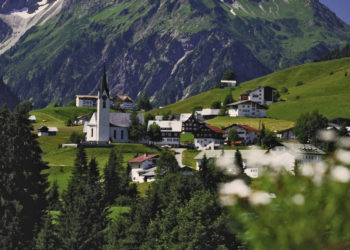


Left: Herbs out of his vegetable garden
Right: Row upon row, wheels of cheese lie next to each other, regularly monitored by Helmut Schuster

C Jeremias Riezler, Kleinwalsertal, Riezlern, © Dietmar Denger
Jeremias Riezler lives out the concept of regionality, and serves it up with every dish.
Atop the Widderstein, the highest mountain in the Kleinwalsertal, he took a decision: henceforth, he would only cook with ingredients from the region he could see from there.
TEXT: ANNE SCHÜSSLER
If anyone knows what regional cuisine is all about, then it’s him: Jeremias Riezler, 38, chef in the Kleinwalsertal. He manages the “ Walserstuba” hotel in Riezlern, at the entrance to the Kleinwalsertal, along with his wife Bettina and his parents Jodok and Ulrike. Their two daughters Klara, six, and Theresa, four, also help create an informal family atmosphere in the hotel, sometimes keeping the guests company at dinner.
The native Walser Jeremias left his roots for the big wide world during his training as a chef or, rather, he went as far as Switzerland, the Allgäu and Wörthersee. “The most exciting thing about it, however, was coming home”, he says. “I was motivated and cocky, and thought I had to win over the world of the Kleinwalsertal with these special global products I had come to know during the years of my training. Yet the guests couldn’t have given a fig about such things. Nobody was interested in dining on turbot”, relates Jeremias with that infectious laugh of his. And so he decided to revamp his entire kitchen and its offerings, and to only use regional products in future.
So does that mean that only products from the Walsertal make it to the table? No, that isn’t feasible, since some things simply aren’t available in the valley. For this reason, Jeremias buys pork, chicken and certain types of fruit and vegetables from other regions of the state of Vorarlberg and neighbouring Allgäu. Naturally, he sources everything in organic quality. Animal husbandry appropriate to the species is absolutely essential for him. “The best meat comes from game from the Walsertal mountains anyway, the animals have such a good life”, he enthuses. “And that is apparent in its flavour.”
When I am standing on the Widderstein, our highest mountain here in the valley, everything I can see from there is my home. The products I use have to come from here. That, to me, is regionality
Jeremias picks the matching herbs for his dishes from his own vegetable garden behind the “Walserstuba”. The garden is a paradise of countless fragrant, appetising flowers and herbs. Three happily quacking ducks swim in the pond, curiously observed by donkeys Raoul and Laurentius. Bearing his wooden basket, Jeremias sets off in the morning to pick what he needs in the kitchen that evening. His garden grows sage, chives, thyme, mint, nasturtium, lemon balm and much more. He also pops in to see his chickens. “It is an indigenous breed”, explains the chef. “They lay eggs, of course, but also give a lot of meat.”
Jeremias cannot source all of his products down here in Riezlern – he has to head upwards for some foods. This time we get to accompany him. For his beloved alpine cheese, he ascends 1,500 metres to the Stutz alp. It is located above Hirschegg, far into the valley. The operator of the chair lift greets Jeremias warmly – he is a well-known figure around these parts. Yet his many awards from the Gault Millau restaurant guide and other bodies have also made Jeremias well-known far beyond the borders of the Kleinwalsertal. He has just been named the national winner of the “GenussWirt for 2015/2016” competition – not for the first time. The chair lift takes us upwards to the Sonna alp. It belongs to Jeremias’ cousin Wolfram, who drives us to the Stutz alp. The two men take advantage of the drive to swap news.
Jeremias ascertains the degree of maturity and quality of a wheel of cheese by the sound
Ten minutes later we reach the alp, which turns out to be a rustic hut with a lovely view of the valley. Hikers can take a break in the small beer garden with wooden benches or in the restaurant. Helmut Schuster, known as Helle, and his wife Andrea run the hut and make the cheese that Jeremias is such a fan of. The family has owned the alp for a century, with the milk for the cheese coming from their own herd of cows.
The wooden house has some nooks and crannies, bestowing it with a charm of its very own. The restaurant smells of fresh herbal tea and hot coffee. First of all, Helle shows us his cellar, where the wheels of cheese are stored. A huge wooden barrel stands in front of the door to the cellar room. In it, two cheeses float in a brine solution. “This is what gives it the right taste”, explains Helle. It is really dark in the cellar room, with the wheels of cheese lying next to each other on wooden boards. There is the fresh, intensive fragrance of cheese and salt. Jeremias gently taps a wheel of cheese. For: no kidding, he ascertains the degree of maturity and the quality of the alpine cheese by its sound. The more hollow the sound, the more holes it has formed – meaning that it has been matured for a long time.
Now it is time for a glass of water with home-made elderberry syrup before returning to the chair lift and the valley, since Jeremias wants to pay a visit to the Xond farm shop.
The Fritz family’s farm is located but a couple of hundred metres from the “Walserstuba”. The special feature on this farm are its goats. Farmer Bernhard Fritz makes goat’s cheese from their milk. Some time ago, the family opened up its own farm shop where Jeremias likes to do his shopping. “There is always something to rummage about in, they are constantly introducing new products, but above all they have good goat’s cheese and good beef ham.” Incidentally, Xond means healthy, and that is what it is all about here. The farm shop, with its wood-panelled walls, is small, which makes it really homely. It smells vaguely of freshly cut wood and the expansive Vorarlberg forests.
Jeremias loves time travel: he cooks old dishes and their modern interpretations
Every evening, Bernhard fetches the goats from the meadow and takes them back to their shed to be milked. He needs to herd them across the main road to the farm. If you imagined this were complicated, you would be wrong – the goats follow the goatherd quickly: indeed, it is almost as if they have been trained to do so. The bells around their necks ring wildly, a couple of pedestrians stop to watch.
Jeremias and his team cook for their guests every evening. The meals that they cook are based on seasonal ingredients. Before they get cracking in the kitchen, we ask what is on the menu this evening. However, he only laughs: “I haven’t a clue!” We’ll just have to wait and see then! Jeremias’ hobby horse is culinary time travel. He cooks a traditional dish, with a modern interpretation as a side. “It is important to me to pass Walser traditions down and to give them a new lease of life,” he says. This also includes old methods of cooking. Jeremias has gained much of his knowledge from old cookbooks, some of which were written by hand. His favourite cookbook is from Walser mountain farmer Anastasia Drechsel, who wrote down all her recipes between 1907 and 1910.
Our ancient dish: a piece of boiled pork on “Riebel”, made from cornmeal and semolina, and chanterelles. For the modern interpretation, Jeremias replaces the pork with a steak featuring chanterelle crackling. Even as he is dressing the plate, we start watering at the mouth. And we finish our plates much too quickly because it tasted so good. We are actually full – however, Jeremias has been busy and that wasn’t all. On two slate plates, he prepares fir shoots with honey, and lovingly places a piece of venison filet on top.
Unser altes Gericht: ein gekochtes Stück Schweinefleisch auf Riebel – einem Gericht aus Mais- und Weizengrieß – und Pfifferlingen. In der modernen Variante ersetzt Jeremias das Schweinefleisch durch ein Steak mit Pfifferlingkruste. Schon als er den Teller anrichtet, läuft uns das Wasser im Mund zusammen. Und dann haben wir viel zu rasch aufgegessen, weil es so lecker schmeckt. Eigentlich sind wir schon satt, doch Jeremias hat noch mehr vorbereitet. Auf zwei Schieferplatten richtet er junge Tannensprossen mit Honig an und setzt liebevoll ein Stück Rehfilet darauf.
He doesn’t even manage to get this dish as far as our table: we tuck in to the filet still in the kitchen, doing away with cutlery, dipping it into the honey again and again. Jeremias sends us a mischievous grin. “That’s the way I expect satisfied guests to look!” Without a word, he disappears to the back of the kitchen, a smile on his face. To fetch new ingredients.

At 2,526 metres, the Große Widderstein is the highest mountain in the south-eastern Walsertal mountains. They are a small mountain group of the Allgäu Alps and border the Lechtal Alps to the east and the south east, with the foothills of the Alps to the north. The Widderstein borders the Lechquellen mountains/Arlberg and the Bregenzerwald to the south and the west.
Further information about the “Walserstuba” is available at:
Walserstuba
Further information about the region available at:
Kleinwalsertal